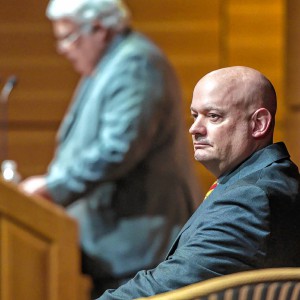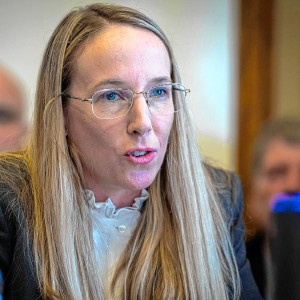Windsor woman with Ehlers-Danlos syndrome becomes advocate for awareness
| Published: 05-31-2019 10:43 AM |
WINDSOR — As a child growing up in Windsor, Taylor Galgay experienced what seemed to be a variety of unrelated symptoms, including severe leg pain, difficulty gaining weight, headaches and back pain.
She managed the pain with liquid Tylenol and Advil. Doctors chalked it up to growing pains. They attributed the headaches to too much screen time or sugar. She really liked chocolate milk.
At the age of 14, she developed scoliosis so severe that she had to have her spine fused. As an adult, Galgay, now 23, continued to struggle with symptoms from migraines, heavy menstrual bleeding, digestive problems and joint pain.
Finally, a referral to Mt. Ascutney Hospital and Health Center rheumatologist Dr. David Podell last December led to a diagnosis that explained it all: Ehlers-Danlos syndrome, a genetic connective tissue disorder resulting from a difference in collagen, a common protein found in tendons, ligaments, skin and muscles that gives skin its structure and strengthens bones. Ehlers-Danlos occurs in about one in 5,000 people.
There are 13 types of Ehlers-Danlos. Galgay has the most common type, hypermobility, which is characterized by loose joints that move beyond typical limits and chronic pain.
Upon learning her diagnosis, her first response was “Sweet, I’m not dying,” she said during an interview last week.
But, she later came to consider it a “bittersweet diagnosis.”
Though not a terminal illness, Ehlers-Danlos has no cure, said Podell, who is chairman of the Department of Medicine at Yale University School of Medicine in Connecticut and comes up to Mt. Ascutney once a week.
Article continues after...
Yesterday's Most Read Articles
Despite that, Podell said he finds that patients can find relief in knowing that there’s a reason for their pain and that they’re not alone.
“Sometimes just knowing what it is can be reassuring,” he said.
Though Ehlers-Danlos comes in varying degrees of severity, Podell said he finds that most patients can enjoy a normal life with the help of physical therapy and muscle strengthening to protect joints and prevent them from being overworked.
There are, however, vascular conditions that may be life-limiting for some, he said.
Podell, as a rheumatologist who focuses on joints, may be more aware of Ehlers-Danlos than the average physician.
It “can be difficult to find physicians who have even heard of our condition,” said Shani Weber, a patient and community adviser with the Maryland-based Ehlers-Danlos Society.
Weber herself was not diagnosed until she was 40, she said. This was despite the fact that she began exhibiting symptoms from an early age. She had gastrointestinal problems as a baby, she said. She has long had joint instability, so that a hug from her daughter can displace a rib. Weber also has struggled with problems with vision, dental overcrowding and difficulties with her autonomic system, which is responsible for digesting food, temperature regulation, blood pressure, heart rate, blinking and tear production.
The primary difference Weber said her eventual diagnosis made in her life was that it explained why her body was different from other people’s.
“That kind of validation of course is huge,” she said.
It also can affect treatment. While people with some other conditions may be advised to push through the pain, Weber said those with Ehlers-Danlos are advised to try a different movement or exercise that doesn’t hurt. The diagnosis also helped Weber gain access to pain management specialists.
In an effort to increase awareness of the condition, improve diagnosis and raise money for research, the society recognizes the month of May as an awareness month and provides people with a template to bring to their legislators for statewide recognition of the condition.
Galgay, a Windsor resident and 2014 Windsor High School graduate, found the society’s website online. After noting that Vermont was not among the states that recognized May as Ehlers-Danlos Awareness Month, she thought “I’m going to have to change that.”
She contacted state Rep. Zachariah Ralph, of Hartland, who agreed to introduce the resolution, H.C.R. 170, which the House adopted in mid-May.
“That was a lot easier than I thought,” Galgay said.
Sarah Strauss, of Essex, Vt., started a support group for Vermonters with Ehlers-Danlos in 2015. Strauss learned she had the condition when her recovery after the birth of her son lasted longer than seemed normal. She also had a cousin who had been diagnosed.
“I found that there were not a lot of resources for people who had been newly diagnosed,” Strauss said.
The group meets quarterly at the University of Vermont Medical Center in Burlington, where Strauss said she hopes to educate providers about the condition.
Though Strauss said she was aware of the society’s effort to have state legislatures recognize May as Ehlers-Danlos Awareness Month, she and the roughly 300 members of the support group had never found the time or energy to pursue it.
“When I heard that Taylor had done it, I was like, ‘Yes!’ ” Strauss said.
Galgay, a medical secretary who is studying psychology online through Granite State College and hopes to attend medical school eventually, said she manages her Ehlers-Danlos by limiting her movement to avoid wear and tear on her joints. She uses heating pads and breathing exercises to manage her pain. She follows a diet recommended for patients with colitis — inflammation of the digestive tract — and avoids seeds, dairy and red meat.
The condition will affect her future in some ways. She will be unable to safely carry a child and surgery would be an inappropriate specialty for her due to the amount of time surgeons spend standing, she said. Instead, she said she hopes to specialize in oncology or hospice care.
Greater recognition of the condition, she said, will help alleviate one of Ehlers-Danlos’ most challenging aspects: it’s invisibility.
“I feel like I am constantly judged and cannot express my pain without someone trying to say, ‘Well just wait until you’re my age. You have nothing to complain about,’ ” she said.
State Rep. John Bartholomew, D-Hartland, a retired veterinarian, co-sponsored the awareness month resolution. Bartholomew said that he was contacted by another constituent around the same time who is seeking greater recognition for another rare condition.
As a result, next legislative session Bartholomew said he plans to introduce legislation that would create a Vermont Rare Disease Advisory Council to take a broader look at rare diseases and conditions that may often go undiagnosed, which in some cases can be life-threatening.
“You go to the doctor (and) you have some signs of an illness, they don’t often think of the more unusual ones,” Bartholomew said.
Nora Doyle-Burr can be reached at ndoyleburr@vnews.com or 603-727-3213.

 Over Easy: ‘A breakfast without a newspaper is a horse without a saddle’
Over Easy: ‘A breakfast without a newspaper is a horse without a saddle’ Lawsuit accuses Norwich University, former president of creating hostile environment, sex-based discrimination
Lawsuit accuses Norwich University, former president of creating hostile environment, sex-based discrimination In divided decision, Senate committee votes to recommend Zoie Saunders as education secretary
In divided decision, Senate committee votes to recommend Zoie Saunders as education secretary
